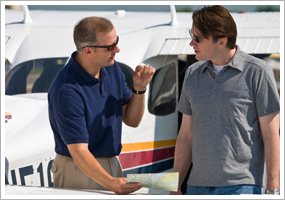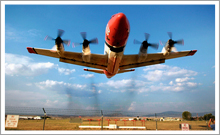| ||||
| | FT News | INSIDE AOPA | TRAINING PRODUCTS | FINAL EXAM | |||
TRAINING TIPsFinish-up resolutions
Start by taking inventory of your training needs with your instructor. (That’s the goal of AOPA’s Flight Path program, which guides you through all the stages of training and lets you track your progress with a personal My Flight Path page.) Your list of finish-up tasks may include polishing off a few hours of solo, cross-country, or night flying. You also may need to complete your knowledge test or log the three hours of test prep required “within the preceding two calendar months from the month of the test,” according to FAR 61.109.
Perhaps it’s not a time requirement that needs more attention, but a specific piloting task. Schedule a lesson focused on that task—but don’t wait until you’re on the ramp preflighting before you think about it again. Devote some ground study to reviewing your past work in the task well beforehand. Does your landing flare need work? Does your crosswind technique need more practice? Then check your understanding of the task against the plentiful reference material available on AOPA Online, and acquire the “Crosswind confidence” described in the Nov. 27, 2009, “ Training Tip.”
Is scheduling holding you back? Be your own advocate! Get commitments from your CFI and your flight school that finishing your training is their top priority, too. If necessary for a serious push, propose bringing a second instructor into action. (An added benefit of this idea is that it provides you with finish-up insurance in case that flying job your CFI applied for ages ago comes through just when you need her most.)
Some people need deadline pressure to get the job done. If that sounds like you, with your finish line in sight, scheduling your checkride a few weeks out may provide the needed spark.
Taking charge to conquer delays was the subject of an August 1994 AOPA Pilot feature, and many pilots have shared their stories since then. Learn from their tales, and then make 2010 the year you add your experience to the pool of knowledge. YOUR PARTNER IN TRAININGThe future of flight training has arrived. Almost a thousand of Cessna’s SkyCatcher light sport aircraft are bound for the nation’s flight schools. That means current and future students are likely to fly one at some point. Get a first glimpse of the intriguing airplane with Alton K. Marsh’s pilot report in AOPA Pilot. And keep an eye out for the March issue of AOPA Flight Training, which will cover more of the aspects specifically related to training.
Did you know that student pilots who join AOPA are three times more likely to complete their flight training? Membership includes unlimited access to aviation information by phone (800/USA-AOPA, weekdays from 8:30 a.m. to 6 p.m. Eastern time) or from AOPA Flight Training Online or AOPA Online. If you’re not already a member, join today and get the pilot’s edge. Login information is available online. FLIGHT TRAINING NEWSLearn to fly a warbirdFor those students looking for a new training challenge, the Wings of Dreams museum at the Keystone Heights Airport in Starke, Fla., now offers training in its restored World War II-era B-25 bomber. The historic airplane, nicknamed Tondelayo, saw action in the Pacific theater and is now owned by the Collins Foundation. Bob Oehl, one of the founders of the Wings of Dreams museum, instructs in the B-25. Pilots of any experience level are welcome to see what it’s like to take the controls and fly the notorious aircraft. Agricultural aviation scholarship establishedBASF Crop Protection and the National Agricultural Aviation Association (NAAA) have teamed up to provide a scholarship fund for potential future ag pilots. BASF will donate $5,000 to the fund for three years beginning in 2011, and NAAA will distribute the awards to students for flight training or agriculture-related coursework at a college or university. According to BASF, the scholarships are a way to highlight the industry and help those students trying to get established in the profession. Aviation helps teach students mathA group of California middle school students had the chance to learn the real-life benefits of math recently as part of Space/Aviation Week at Temecula Middle School. Students were taught how to plan a flight from San Francisco International Airport to a point 14 miles away. By using the formula “distance equals rate times time,” each was able to pinpoint how long the trip would take. Then Mobile Flight Simulation brought in a simulator and let the students actually fly the trip. “The whole purpose is to spark that interest in a field that involves math,” said sixth-grade teacher Kelly Manzani. “Then they’re going to want to do that math, and this is a college-bound career.” Barnhart named UAA presidentKurt Barnhart, head of the aviation program at Kansas State University in Salina, has been elected president of the University Aviation Association (UAA). Barnhart, a flight instructor and A&P mechanic, will run the association for one year. UAA represents 525 educators, students, and college and university aviation programs. The announcement was made at the association’s conference and awards banquet in Wichita, Kan. A resolution worth keepingThe AOPA Air Safety Foundation has a resolution that you’ll want to keep. The foundation is challenging students to make a New Year’s resolution to become a safer, smarter pilot in 2010. Will you accept the challenge to complete at least one safety course each month in the new year? Courses cover a wide variety of topics, including aerodynamics, radio communication, runway safety, the aircraft engine, and more. Accept the challenge and resolve to be a safe, smart pilot in 2010. inside aopaAOPA Insurance Agency to help fund safety quizzesThe AOPA Insurance Agency, a wholly owned subsidiary of AOPA, is taking an innovative direction to help hold the line on aircraft insurance costs. The agency on Dec. 21 presented a check to the AOPA Air Safety Foundation to help develop and distribute the foundation's safety quizzes, available online free of charge to all pilots. Read more >> FAA to preserve needed ground-based approachesHaving a variety of instrument approaches available for training and real-world flying is critical. As the FAA tries to save money, it has been canceling what it calls redundant instrument approach procedures. AOPA carefully reviews each notice to ensure that neither training nor operational capability is reduced in the cancellations. Recently, AOPA recommended that the FAA not cancel 22 ground-based approaches, and the agency subsequently decided to keep those approaches. Read more >> TRAINING PRODUCTSFree ‘Airspace and Communications Cockpit Card’King Schools is offering a free Airspace and Communications Cockpit Card with every order. The card includes pertinent information in a quick-reference format. The laminated card includes airspace rules and memory aids to keep users safe and legal in the complex world of airspace. The flight training provider also is offering its course on risk management for free when your order exceeds $450. Visit the Web site for more information.
Note: Products listed have not been evaluated by ePilot editors unless otherwise noted. AOPA assumes no responsibility for products or services listed or for claims or actions by manufacturers or vendors. FINAL EXAMQuestion: My instructor and I hit a bird while flying in the practice area. We landed safely, but I am wondering if we need to report this.
Answer: Pilots involved in a bird strike are urged to report it to the FAA on form 5200-7. If the strike happened near the surface of the airport, you should also advise the tower or other pilots as well as the airport manager so that the remains can be removed from the runway or taxiway. Read more about bird strikes in AOPA’s subject report.
Got a question for our technical services staff? E-mail [email protected] or call the Pilot Information Center, 800/872-2672. Don’t forget the online archive of “Final Exam” questions and answers, searchable by keyword or topic. Picture Perfect
AVIATION EVENTS & WEATHER To submit an event or to search all events in the calendar, visit AOPA Online. For airport details, including FBO fuel prices, see AOPA’s Airport Directory Online. Flight Instructor Refresher ClinicsThe next AOPA Air Safety Foundation Flight Instructor Refresher Clinics are scheduled in San Jose, Calif., Baltimore, Md., and Detroit, Mich., Jan. 9 and 10; Costa Mesa, Calif., Jackson, Miss., and Charlotte, N.C., Jan. 16 and 17; San Antonio, Texas, and Seattle, Wash., Jan. 23 and 24; Rochester, N.Y., Portland, Ore., and Sevierville, Tenn., Jan. 30 and 31. For a complete schedule, see AOPA Online.
Can’t make it in person? Sign up for the CFI Refresher Online. AOPA Air Safety Foundation Safety SeminarsAOPA Air Safety Foundation Safety Seminars are scheduled in Mesa, Ariz., and Reno, Nev., Jan. 11; Tucson, Ariz., and Sacramento, Calif., Jan. 12; Milpitas, Calif., Jan. 13; Santa Rosa, Calif., Jan. 14; San Diego, Calif., Jan. 25; Costa Mesa, Calif., Jan. 26; Ontario, Calif., Jan. 27; Burbank, Calif., Jan. 28; Little Rock, Ark., Feb. 1. Topics vary—for details and a complete schedule, see AOPA Online. | Got news? Contact ePilot. Having difficulty using this service? Visit the ePilot Frequently Asked Questions now at AOPA Online or write to [email protected]. |
| Member Tools : Send feedback | Update member profile | Change email address | Unsubscribe | ePilot Archive Editorial Team : ePilot Flight Training Editor : Ian Twombly | ePilot Editor: Sarah Brown | Contributor: Alton Marsh |

 Happy new year! An excellent New Year’s resolution for any student pilot is to assess your flight training program’s progress, and then take positive steps to move it forward. Or, if you’re close enough to the goal, resolve to get the certificate project finished.
Happy new year! An excellent New Year’s resolution for any student pilot is to assess your flight training program’s progress, and then take positive steps to move it forward. Or, if you’re close enough to the goal, resolve to get the certificate project finished.


